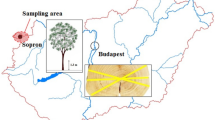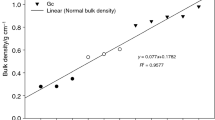Abstract
Thermogravimetry, differential thermal analysis, differential scanning calorimetry in oxygen flux were used to characterize two wood types: fir and chestnut woods. They were characterized by the peak temperatures of DTA, DTG and DSC curves and by the different mass losses evaluated on the basis of the measured thermal data. The samples were woods in powder obtained during sawing. Complementary characterization of the woods was performed by estimating the crystallinity of cellulose by means of X-ray powder diffraction. In order to simulate the degradation of wet woods, fir and chestnut woods were put into deionised water and into artificial sea water for several weeks; some samples of woods contained Cu and Fe nails to ascertain the effect of these metals on the degradation process. The thermal and X-ray diffraction measurements were then performed on the wet woods, following the same previous procedure. X-ray fluorescence was used to investigate the penetration of metals into wood samples.
Similar content being viewed by others
References
S. Vicini, E. Princi, G. Luciano, E. Franceschi, E. Pedemonte, D. Oldak, H. Kaczmarek and A. Sionkowska, Thermochim. Acta, 418 (2004) 123.
E. Princi, S. Vicini, E. Pedemonte, A. Mulas, E. Franceschi, G. Luciano and V. Trafiletti, Thermochim. Acta, 425 (2005) 173.
P. Calvini, A. Gorassini, G. Luciano and E. Franceschi, Vibr. Spectr., 40 (2006) 177.
S. Vecchio, G. Luciano and E. Franceschi, Ann. Chim., 96 (2006) 715.
S. Soares, G. Camino and S. Levchik, Polym. Degrad. Stab., 49 (1995) 275.
A. L. Dupont and J. Tétreault, Stud. Conserv., 45 (2000) 201.
M. Bartkowiak and R. Zakrzewski, J. Therm. Anal. Cal., 77 (2004) 295.
L. Campanella, M. Tomassetti and R. Tomellini, J. Thermal Anal., 37 (1991) 1923.
S.-I. Tsujiama and A. Miyamori, Thermochim. Acta, 351 (2000) 177.
B. Kaye, D. J. Cole-Hamilton and K Morphet, Stud. Conserv., 45 (2000) 233.
L. E. Alexander, X-ray Diffraction Methods in Polymer Science, Ed. Wiley Interscience, 1969, pp. 180–188.
A. J. Varma and V.B. Chavan, Polym. Degrad. Stab., 49 (1995) 245.
DN-S. Hon, Photochemistry of Wood, DN-S Hon and N. Shiraishi, Eds, Wood and Cellulose Chemistry, Marcel Decker, 1991, pp. 525–555.
Author information
Authors and Affiliations
Corresponding author
Rights and permissions
About this article
Cite this article
Franceschi, E., Cascone, I. & Nole, D. Thermal, XRD and spectrophotometric study on artificially degraded woods. J Therm Anal Calorim 91, 119–123 (2008). https://doi.org/10.1007/s10973-007-8372-5
Published:
Issue Date:
DOI: https://doi.org/10.1007/s10973-007-8372-5




